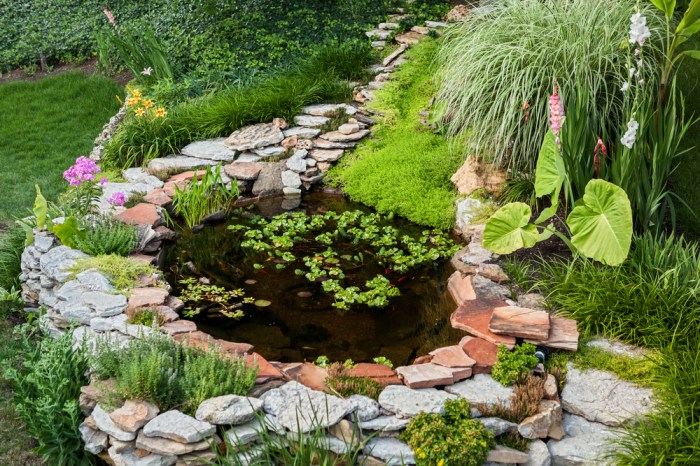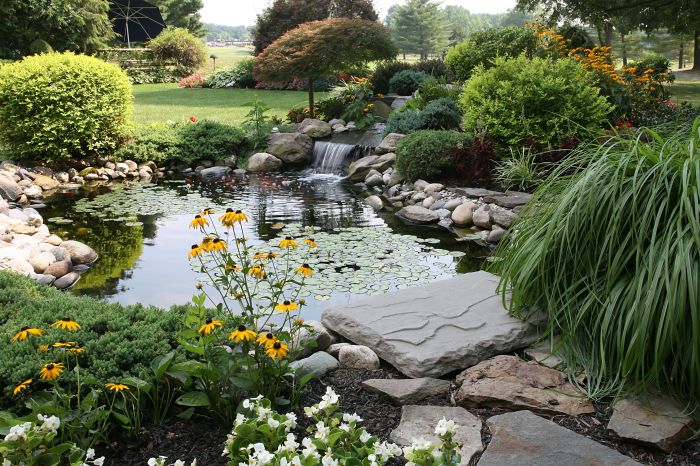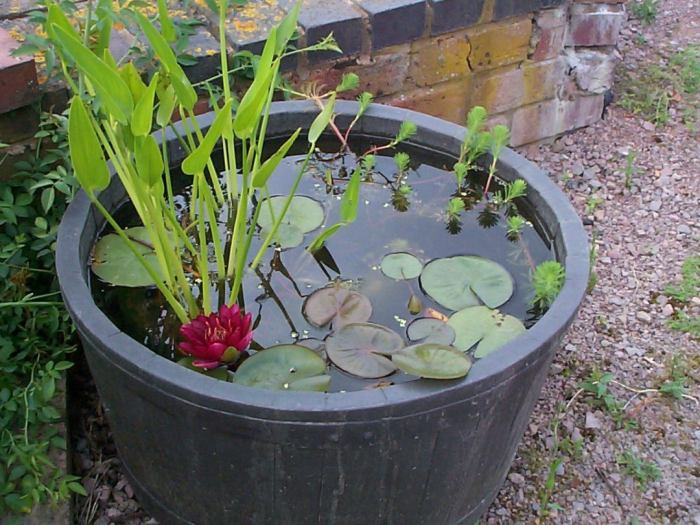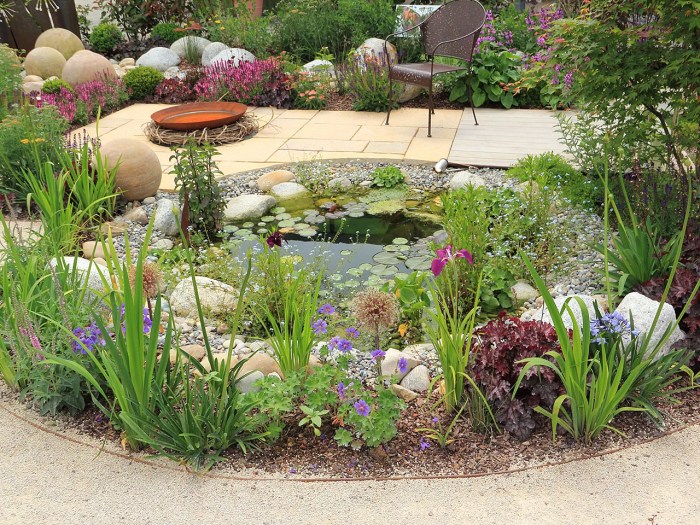For those with limited outdoor space, creating a small pond can be an ideal way to bring nature’s tranquility into their own backyard. Selecting the best plants for a small pond is crucial, as they play a vital role in enhancing its aesthetic appeal and ecological balance.
In this comprehensive guide, we will delve into the characteristics of suitable plants, explore their visual impact, and discuss their ecological benefits. We will also provide practical advice on planting and maintenance, along with creative design ideas to maximize the beauty and functionality of your small pond.
Ideal Plants for Limited Space

For small ponds with limited space, selecting the right plants is crucial. Ideal choices are those that remain compact, possess shallow root systems, and can withstand fluctuating water levels.
Here are some specific plant species that meet these criteria:
Water Lilies
- Nymphaea odorata(American White Water Lily): Fragrant white flowers, round leaves
- Nymphaea pygmaea(Dwarf Water Lily): Small, star-shaped yellow flowers, tiny pads
- Nymphaea alba(White Water Lily): Large, pure white flowers, heart-shaped leaves
Marginal Plants
- Iris versicolor(Blue Flag Iris): Sword-shaped leaves, blue-purple flowers
- Juncus effusus(Soft Rush): Grass-like foliage, adds texture and height
- Sagittaria latifolia(Arrowhead): Arrow-shaped leaves, white flowers
Oxygenators
- Elodea canadensis(Waterweed): Feathery foliage, provides oxygen and shelter
- Ceratophyllum demersum(Hornwort): Submerged plant, oxygenates water and provides hiding spots
- Myriophyllum spicatum(Eurasian Water Milfoil): Delicate foliage, effective oxygenator
Aesthetic Considerations: Best Plants For A Small Pond
The visual appeal of plants in a small pond setting plays a crucial role in enhancing its aesthetic value. Consider the following factors to create a visually stunning arrangement:
Color
Choose plants with contrasting or complementary colors to create a vibrant display. For instance, the deep purple blooms of water hyacinths complement the delicate white flowers of water lilies. Alternatively, the lush green foliage of watercress provides a backdrop for the bright yellow blooms of marsh marigolds.
The best plants for a small pond add beauty and life to your water feature. Water lilies and irises are classic choices, while marginal plants like rushes and sedges provide structure and texture. If you have a shaded patio, consider incorporating some of the best plants for shaded patios into your pond design.
Hostas, ferns, and impatiens can tolerate low light conditions and add a touch of greenery to your water garden. For the best results, choose plants that are native to your area and that are well-suited to the size and depth of your pond.
Texture
Incorporate plants with varying textures to add depth and interest. The smooth, glossy leaves of water lilies contrast with the feathery foliage of maidenhair ferns, while the spiky leaves of irises add a touch of drama.
When selecting plants for a small pond, it’s crucial to consider their suitability for the environment. Many aquatic plants thrive in small ponds, providing both aesthetic appeal and ecological benefits. For those looking to create a vibrant underwater ecosystem in a betta vase, similar principles apply.
While betta vases may be smaller in scale, they offer a unique opportunity to cultivate best plants for betta vase that complement the vibrant colors of these fish. Returning to the topic of small ponds, it’s essential to select plants that are not only visually appealing but also contribute to the overall health of the aquatic environment.
Bloom Time
Select plants that bloom at different times throughout the growing season to ensure continuous visual interest. Water lilies, for example, bloom in summer, while irises bloom in spring and early summer. By combining plants with staggered bloom times, you can create a pond that is visually appealing from spring to fall.
Ecological Benefits

Plants play a vital role in maintaining the health and biodiversity of small ponds. They provide shelter and breeding grounds for a variety of wildlife, including frogs, insects, and birds. They also help to filter the water, removing pollutants and excess nutrients, and they produce oxygen through photosynthesis, which is essential for aquatic life.
Small ponds are an excellent addition to any garden, and the right plants can make all the difference. When choosing plants for a small pond, it’s important to consider factors such as size, growth rate, and water depth. For those interested in keeping axolotls, it’s worth noting that certain plants are particularly well-suited for these fascinating creatures.
For instance, Java moss provides hiding places and a natural food source for axolotls. Other suitable options include hornwort, water sprite, and duckweed. When selecting plants for a small pond, it’s essential to choose a variety that will thrive in the given conditions and enhance the overall aesthetic of the pond.
Different plant species have specific roles to play in supporting a balanced ecosystem in a small pond. Submerged plants, such as hornwort and waterweed, provide cover for fish and other aquatic creatures and help to oxygenate the water. Floating plants, such as water lilies and duckweed, provide shade and shelter for wildlife and help to control algae growth.
Emergent plants, such as cattails and rushes, help to stabilize the pond’s shoreline and provide nesting sites for birds.
Water Quality Improvement
Certain plants are particularly effective in improving water quality in small ponds. Water hyacinth and duckweed are known for their ability to absorb excess nutrients, such as nitrates and phosphates, which can lead to algae blooms and other water quality problems.
Water lilies and lotuses have large leaves that help to shade the water, reducing the amount of sunlight available for algae growth.
Beneficial Insects
Plants in a small pond can also attract beneficial insects, such as dragonflies and damselflies, which prey on mosquitoes and other pests. These insects help to control the population of these pests, reducing the risk of disease transmission and making the pond a more enjoyable place to be.
Planting and Maintenance
Establishing and maintaining a thriving ecosystem in a small pond requires careful planting and ongoing care. Understanding the specific needs of the chosen plants, along with proper spacing and watering techniques, is crucial for their well-being.
Regular maintenance tasks, such as pruning, fertilizing, and pest control, are essential to keep the plants healthy and the pond aesthetically pleasing. In colder climates, overwintering measures or protection from extreme weather conditions may be necessary to ensure the plants’ survival.
Planting and Spacing
- Choose plants suitable for the size and depth of the pond.
- Determine the appropriate soil requirements for each plant and amend the pond soil accordingly.
- Space plants according to their growth habit, allowing ample room for root development and preventing overcrowding.
Watering
Water plants regularly, especially during hot and dry weather. The frequency and amount of watering will vary depending on the plant species, soil moisture, and climate.
Pruning
- Regular pruning removes dead or damaged foliage, promotes new growth, and controls the size and shape of the plants.
- Prune in the spring or fall, avoiding pruning during the peak growing season.
Fertilizing
- Fertilize plants periodically with a balanced fertilizer to provide essential nutrients for growth and blooming.
- Follow the manufacturer’s instructions for application rates and frequency.
Pest and Disease Control
- Monitor plants for pests and diseases, such as aphids, spider mites, or fungal infections.
- Use organic or chemical control methods as needed, following recommended safety precautions.
Overwintering, Best plants for a small pond
In colder climates, some plants may require protection from freezing temperatures. Methods include:
- Moving plants indoors or to a greenhouse.
- Covering plants with mulch or burlap.
- Submerging hardy plants in deeper water.
Creative Design Ideas

Incorporating plants into the design of a small pond can transform it into a visually captivating and ecologically vibrant space. From floating plants that add a touch of whimsy to submerged species that provide hiding places for fish, there are endless possibilities for creating a unique and harmonious ecosystem.
By thoughtfully arranging plants, you can create different zones within the pond, each with its own distinct character. Shallow areas can be adorned with marginal plants that bring color and texture to the water’s edge, while deeper areas can accommodate submerged species that provide shelter and oxygenation.
Innovative Plant Display Ideas
- Floating Islands:Create floating islands by attaching plants to lightweight materials like cork or Styrofoam. These islands can be moved around the pond to create dynamic visual displays.
- Vertical Gardens:Utilize vertical space by attaching plants to trellises or walls around the pond. This technique adds height and interest, especially in small ponds with limited surface area.
- Submerged Sculptures:Incorporate submerged sculptures into the pond and adorn them with plants. These structures provide additional hiding places for fish and create unique underwater landscapes.
Last Recap

With careful consideration and proper care, you can create a thriving small pond ecosystem that is both visually stunning and ecologically beneficial. By choosing the right plants, you can transform your backyard into a sanctuary of tranquility and natural beauty.
Essential FAQs
What are the most important characteristics to consider when choosing plants for a small pond?
Compact size, shallow root systems, and tolerance for fluctuating water levels are key characteristics to look for.
How can I create a visually appealing arrangement of plants in my small pond?
Consider plant height, spread, and seasonal interest when selecting and arranging plants to create a visually pleasing display.
What are some creative ways to incorporate plants into the design of a small pond?
Floating plants can add visual interest, while submerged plants provide hiding places for fish. You can also create different zones within the pond using plants, such as shallow areas for marginal plants and deeper areas for submerged species.